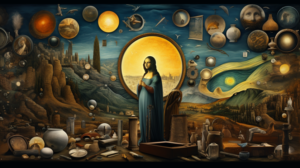
5 Iconic Artists and Their Signature Painting Styles
You’re about to delve into the fascinating world of art! You’ll uncover the secrets behind the signature styles of five iconic artists, from Picasso’s groundbreaking cubism to Pollock’s expressive abstracts.
You’ll not only learn about their techniques, but you’ll also grasp how they revolutionized art.
So, strap in for an enlightening journey through art history. You’re in for a treat, whether you’re an art enthusiast or just dipping your toes in.
Pablo Picasso and Cubism
You can’t discuss iconic artists without mentioning Pablo Picasso, whose over 20,000 works greatly contributed to the revolutionary art movement known as Cubism. This Spanish artist’s evolution is best delineated through his distinctive artistic periods, particularly Picasso’s Blue Period. Here, you observe his exploration of color, mood, and form, with a dominant use of blues and greens, often reflecting a sense of melancholy. This period reveals a young Picasso grappling with social realities, using his canvas as an expressive medium.
Analyzing Guernica, a pivotal piece, displays Picasso’s mature cubist style. This masterpiece is a political commentary, its fragmented, angular forms embodying the chaos and violence of war. Picasso’s genius lies in his ability to express complex narratives through abstraction, forever altering the trajectory of modern art.
Van Gogh’s Post-Impressionist Techniques
Diving into Van Gogh’s post-impressionist techniques, you’ll discover his signature style that’s characterized by bold colors, dramatic, impulsive and expressive brushwork, and contoured forms. His works, such as ‘Starry Night’ and ‘Self Portrait’, are rife for exploration and analysis.
In the ‘Starry Night Analysis’, you’ll notice:
- His use of thick, undulating strokes to depict the night sky’s energy
- Bold, contrasting colors that heighten emotional intensity
- Lack of blending, signifying the artist’s emotional state
- The large, bright moon and stars, symbolizing his struggle with mental illness
Meanwhile, the ‘Self Portrait Exploration’ reveals:
- The use of directional brushwork to convey emotion
- His striking, almost confrontational gaze
- The disjointed color patches, symbolizing his internal turmoil
- The use of dark and light elements that delineate his silhouette
Each technique contributes to the overall emotional impact of Van Gogh’s works.
Salvador Dali’s Surrealist Strokes
Switching gears from Van Gogh’s post-impressionist techniques, let’s delve into the surreal world of Salvador Dali, an artist whose strokes echo a unique blend of reality and dream-induced fantasy.
Dali’s dreamscapes are known for their bizarre, yet meticulously detailed renderings of subconscious thoughts. His paintings, heavily imbued with surrealist symbolism, are a visual feast that challenge the viewer’s perception of reality. Every stroke of Dali’s brush seems to have been guided by the artist’s vivid dreamscapes.
This technique, a fusion of the real and the surreal, is a hallmark of Dali’s style. Each depiction, whether it’s a melting clock or a distorted human figure, serves as a physical manifestation of the artist’s intricate dreams, thus making Dali’s work a compelling exploration of the human subconscious.
Claude Monet: Founder of Impressionism
Leaving behind Dali’s surreal dreamscapes, let’s venture into the luminous world of Claude Monet, the artist who’s often credited as the founder of impressionism. Monet’s unique style, characterized by his loose brushwork and innovative focus on light, color, and atmosphere, became a hallmark of this artistic movement.
Let’s delve deeper into the nuances of Monet’s artistry:
- Monet’s Waterlilies: A series of over 250 paintings, these works exemplify his skill in capturing the fleeting essence of nature.
- Impressionism Evolution: Monet’s experimentation with light and color pushed the boundaries of traditional art, leading to the evolution of impressionism.
- Plein air painting: Monet often painted outdoors to directly capture the changing scenes.
- Rapid brushstrokes: He used these to convey the transience of each moment.
Understanding Monet’s style helps you appreciate his groundbreaking contributions to art.
Jackson Pollock and Abstract Expressionism
Stepping into the realm of Abstract Expressionism, you’ll encounter the dynamic and energetic works of Jackson Pollock, a revolutionary artist known for his unique drip painting technique.
Pollock’s Drip Technique, a method where paint was dripped or thrown onto a canvas, broke traditional boundaries of painting, freeing the artist from the constraints of the easel. The randomness and chaos of the dripped paint patterns embody the essence of Abstract Expressionism, aiming to express emotion through non-representational means.
Pollock’s work reflects the Expressionism Influence, echoing the angst and unrest of the post-war era. His aggressive, kinetic style is a stark contrast to the calm and controlled techniques of previous artists, signifying a significant shift in the artistic landscape.
His impact on Abstract Expressionism is undeniable, forever altering the trajectory of modern art.
Frequently Asked Questions
How Have These Iconic Artists Influenced Modern Art Trends?
You’ve seen how Modern Art’s Evolution has been shaped by iconic artists. They’ve served as Artist Inspirations, influencing trends by infusing their distinctive painting styles into contemporary works.
What Are Some Common Themes These Artists Explored in Their Works?
You’ll find religious symbolism and political commentary as common themes in various artworks. These elements offer deep reflections on society, often prompting viewers to engage in critical discussions about religion and politics.
Can You Elaborate on the Financial Struggles These Artists Faced During Their Lifetime?
Sure, many artists faced significant financial hardships. They developed survival techniques, often altering their artistic choices due to economic influence. Struggles included living in poverty, yet they continually pushed boundaries to produce profound works.
How Did the Personal Lives of These Artists Influence Their Unique Painting Styles?
Artists’ love interests and mental health often deeply influence their work. You can see this in the intensity and emotion in their styles, as personal experiences shape their unique artistic perspectives and techniques.
Are There Any Controversies or Criticisms Related to These Artists’ Signature Styles?
Yes, you’ll find controversies or criticisms surrounding artistic plagiarism claims and interpretation disputes. These issues often stem from critics questioning the originality and meaning of an artist’s signature style.
So, you’ve journeyed through the distinct styles of five iconic artists. You’ve seen Picasso’s Cubism, Van Gogh’s Post-Impressionist techniques, Dali’s Surrealist strokes, Monet’s Impressionism, and Pollock’s Abstract Expressionism. Each artist’s style is a testament to their unique vision and artistic prowess.
As you delve deeper into the world of art, remember, it’s not just about the technique, but the emotion, the message, and the timeless impact art leaves behind.

